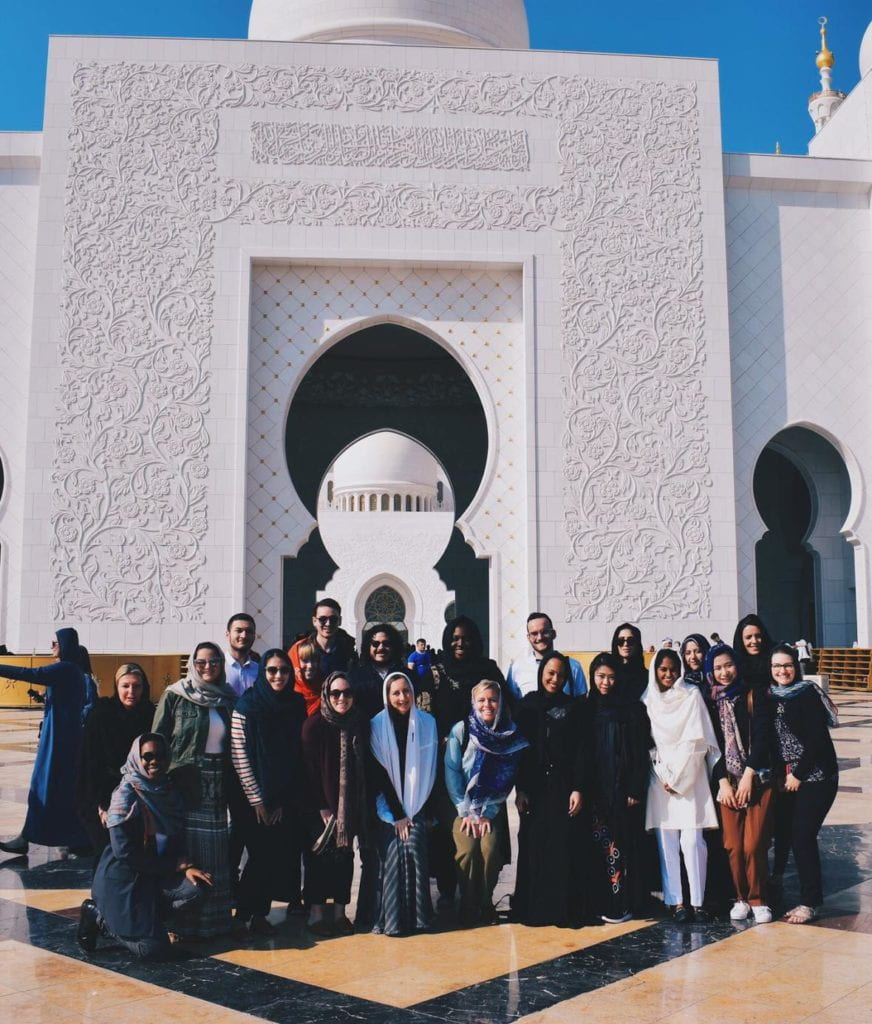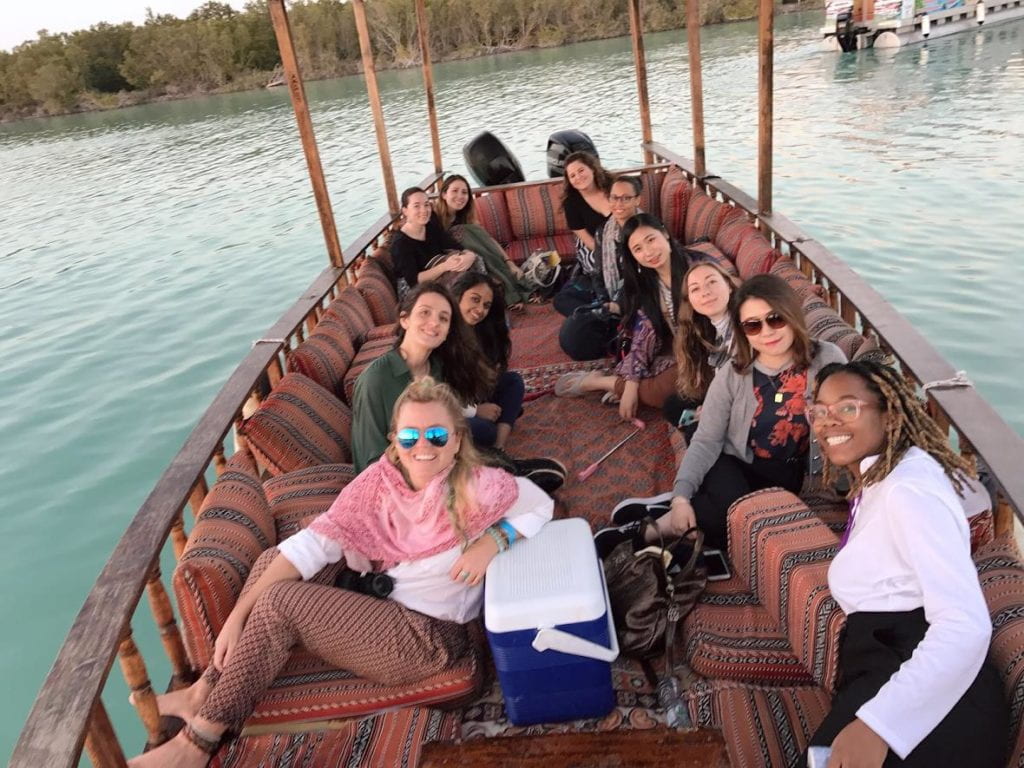By Spencer Harvey, Dillan Jacobson, and Aya Takeuchi
 The United Arab Emirates, a country that has experienced unprecedented economic and developmental growth within the last forty years, has recently emerged as a key player in the advancement of women’s rights in the Gulf Region. This sentiment is captured in the words of Sheikh Zayed bin Sultan Al Nahyan, the founding father of the UAE, who stated that, “The man is a brother to the woman, and woman is a sister to the man. There is no difference between them except in deeds. There are good deeds and bad deeds and only here lies the difference.” This past January, nineteen graduate students from NYU’s Center for Global Affairs were given the opportunity to participate in a Global Field Intensive (GFI), which focused on the fascinating intersection between gender and sustainable development in the United Arab Emirates.
The United Arab Emirates, a country that has experienced unprecedented economic and developmental growth within the last forty years, has recently emerged as a key player in the advancement of women’s rights in the Gulf Region. This sentiment is captured in the words of Sheikh Zayed bin Sultan Al Nahyan, the founding father of the UAE, who stated that, “The man is a brother to the woman, and woman is a sister to the man. There is no difference between them except in deeds. There are good deeds and bad deeds and only here lies the difference.” This past January, nineteen graduate students from NYU’s Center for Global Affairs were given the opportunity to participate in a Global Field Intensive (GFI), which focused on the fascinating intersection between gender and sustainable development in the United Arab Emirates.
The UAE offers a unique socio-political landscape for analysis when compared to other Muslim-majority states, particularly with reference to the distinct makeup of the population; with Emirati nationals accounting for only 10 to 15% of the population. Over the course of 10 days, we visited six of the seven Emirates: Abu Dhabi, Dubai, Sharjah, Umm al-Quwain, and Ras Al-Khaimah. The wealth and developmental disparity between the individual Emirates was starkly evident, and it was interesting to analyze and contemplate these differences throughout the trip. Despite the extreme oil wealth in the region, there is increasing recognition of the need to diversify the economy, and therefore shift from a largely extraction based, to a more inclusive, knowledge-based economy. This has manifested itself in greater emphasis by the country’s leadership on youth and women’s empowerment, with an overarching effort to promote “Emiratization”– an initiative aiming to increase the employment amongst the small population of Emirati nationals. In Dubai, we gained first-hand insight into these developments at our various site visits, including the Ministry of Youth’s innovative “Youth Hub”, the Mohammed Bin Rashid School of Government (MBRSG), and the Dubai Women’s Museum. At the Dubai Foundation for Women and Children (DFWC), we also began to understand some of the challenges and realities faced by women living in the UAE, such as high rates of domestic abuse, stringent divorce laws, and cultural norms that continually disempower women. Although these issues are still, to a degree, public taboos, organizations like the DFWC are actively joining global awareness campaigns, creating open spaces for dialogue, and promoting women’s empowerment initiatives.

As we walked through the streets of Abu Dhabi and Dubai, it was impossible to ignore the rising influence of globalization in a country that consists of mostly desert terrain. Amidst the extravagant architecture, large-scale commercialization, and some of the world’s tallest skyscrapers, the government has demonstrated its commitment to preserve the country’s unique environmental and cultural landscape. From our site visits and meetings at Masdar—a zero carbon and zero waste city—the Environment Agency of Abu Dhabi, the American University of Sharjah, and Mangrove National Park, it is clear that the push for sustainability is not purely symbolic; rather, both the public and private sectors are taking active steps to prevent environmental degradation, promote biodiversity, and mitigate the negative effects of climate change. Additionally, our meeting at CBRE, the largest commercial real estate services and investment firm, allowed us to gain perspective on the distinct challenges associated with rapid commercial development and urban planning, such as enhancing accessibility and the quality of living, as well as promoting sustainable building projects.
For many students, one of the most enlightening aspects of the trip was getting the opportunity to embrace traditional Emirati culture. Through our visits to the Islamic Museum of Civilization in Sharjah, the Sheikh Zayed Grand Mosque, Bedouin tents in Ras al Khaimah, and to camel-race tracks in Dubai, we were exposed to the influence of Islamic culture on Emirati traditions and values. At many of our site visits, where we interacted with Emirati nationals of all different ages and professions, one overarching theme that emerged was the notion of the Modern Muslim—one who preaches co-existence of all cultures and religions, one who does no harm and acts as a global citizen. We witnessed these values being embraced by different organizations established in the UAE, such as Hedayah, an organization dedicated to countering violent extremism and promoting understanding through international dialogue and shared practices.
Finally, it is essential to acknowledge the UAE’s rise as a leader of innovation, not only in the Middle East, but in the global arena. From its establishment of the Louvre in Abu Dhabi, to its visionary planning efforts for Expo 2020 in Dubai, the UAE has become a global hub for culture and design. As a young country with a strong commitment to enhancing its human capital, building innovative technologies, and increasing its global status, it seems as though the possibilities for the future of the UAE are endless. Our experience travelling to the UAE as students, rather than as tourists, allowed us to get a behind-the-scenes look at this multifaceted, modern-day example of a country in transition.
Spencer Harvey, Dillan Jacobson, and Aya Takeuchi are MSGA students who participated in the January 2018 Global Field Intensive to Abu Dhabi.
